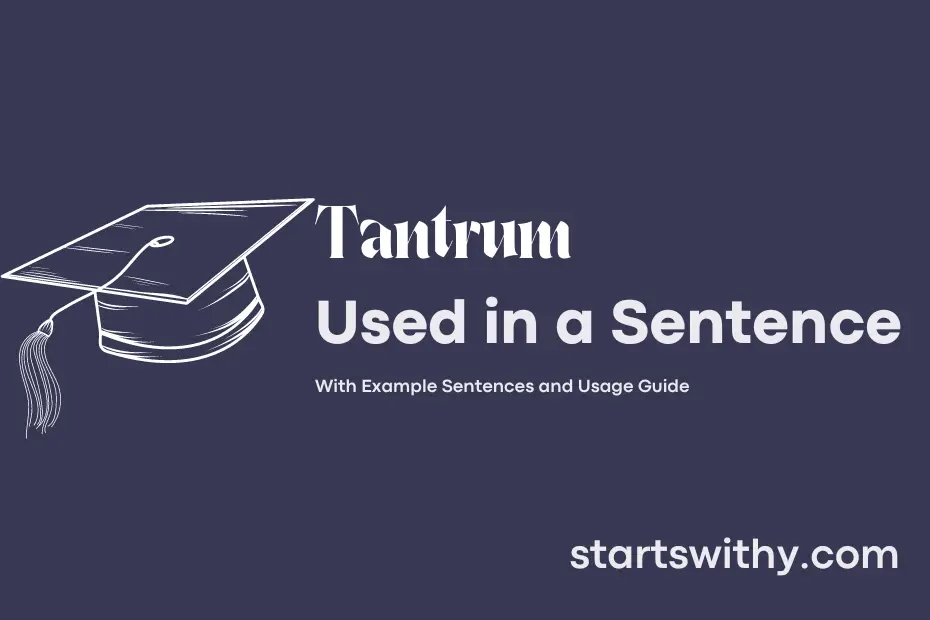Have you ever witnessed a child throwing a tantrum in a public place? A tantrum is a behavioral outburst often characterized by crying, screaming, kicking, and other displays of frustration or anger.
These outbursts are common in young children who are still developing emotional regulation skills. Tantrums can be triggered by a variety of reasons, such as being denied a desired object or activity, feeling overwhelmed or tired, or simply seeking attention. Learning effective ways to manage and prevent tantrums can help both children and caregivers navigate these challenging moments with more ease.
7 Examples Of Tantrum Used In a Sentence For Kids
- During the birthday party, Ravi’s little sister threw a big tantrum because she wanted another piece of cake.
- The boy in the class had a tantrum when his friend took his favorite toy.
- She had a tantrum when she was told it was time to go home from the playground.
- The little girl had a tantrum when her mom said she couldn’t have ice cream before dinner.
- He threw a tantrum when he couldn’t find his favorite teddy bear.
- The boy’s tantrum stopped when his teacher offered him some crayons to draw with.
- She had a big tantrum when her brother accidentally knocked down her block tower.
14 Sentences with Tantrum Examples
- After receiving a poor grade on his exam, Rohan threw a tantrum in the middle of the classroom.
- When the canteen ran out of his favorite dish, Akash had a tantrum and refused to eat anything else.
- During a group project meeting, Riya had a tantrum when her ideas were not chosen by the team.
- After missing the deadline for his assignment, Ankit had a tantrum and blamed the professor for not reminding him.
- When the college decided to cancel an event, Priya threw a tantrum and demanded a refund for her ticket.
- During a debate competition, Aarav had a tantrum when he lost to his opponent.
- Sneha had a tantrum when her roommates borrowed her clothes without asking.
- When the college library closed early, Nisha had a tantrum because she needed to borrow a book for her research project.
- After failing to secure an internship, Sameer had a tantrum and refused to apply to any other companies.
- During a sports event, Vicky had a tantrum when the referee made a call against his team.
- Ritu had a tantrum when the college wifi was down, and she couldn’t submit her online assignment on time.
- When the college changed the exam schedule last minute, Vishaal had a tantrum and accused the administration of being unfair.
- Arjun had a tantrum when his favorite spot in the college cafeteria was taken by someone else.
- During a guest lecture, Kavya had a tantrum when she didn’t agree with the speaker’s viewpoints.
How To Use Tantrum in Sentences?
Tantrum is often used to describe a sudden outburst of anger or frustration. When incorporating this word into a sentence, it is important to keep in mind a few key points.
Firstly, make sure to use tantrum in a context where someone is displaying intense emotional behavior, typically in a negative manner. For example, “The child threw a tantrum in the store when he couldn’t get the toy he wanted.”
Secondly, consider the tone and atmosphere of the situation when using this word. Tantrum implies a lack of control and a heightened emotional state, so choose a sentence that accurately conveys these feelings. An example could be, “She had a tantrum at the meeting when her ideas were dismissed.”
Lastly, be mindful of the audience and setting in which you use the word tantrum. This word can carry negative connotations, so it is important to use it appropriately and with sensitivity.
In summary, when constructing a sentence with tantrum, remember to describe a sudden outburst of anger or frustration, convey the intensity of the emotional reaction, and consider the context in which the word is being used.
Conclusion
In conclusion, dealing with children’s tantrums can be challenging for parents and caregivers. It is important to remain calm and patient during these outbursts, as reacting emotionally can escalate the situation. Using techniques such as positive reinforcement, setting boundaries, and teaching children healthy ways to express their emotions can help prevent future tantrums. It is crucial to remember that tantrums are a normal part of child development and should be handled with understanding and support.
By maintaining consistency in addressing tantrums and being empathetic towards children’s feelings, adults can help them navigate their emotions and learn appropriate ways to communicate and self-regulate. Effective communication and a nurturing environment can go a long way in reducing the frequency and intensity of tantrums, promoting healthy emotional development in children.



